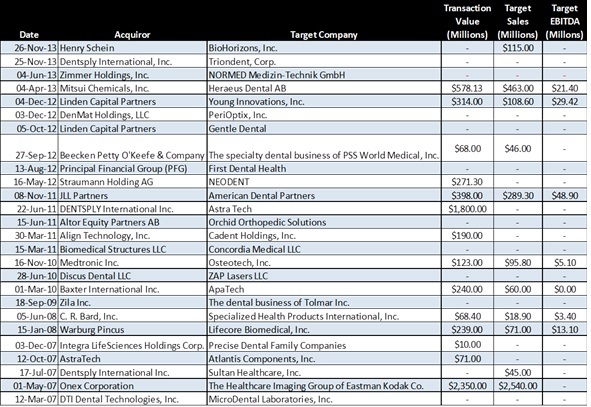Strategic Healthcare Mergers and Acquisitions (M&A)
Dental Market Trends 2014
01/29/2014
As part of our Healthcare M&A and strategic consulting services, we offer the following overview of the Dental market as a context to understand mergers and acquisitions in the sector.
- Changing Demographics
The aging population and increased awareness drive the demand for aesthetic and functional dentistry. Approximately 10% of people over 65 have some form of periodontal disease.According to the U.S. Census Bureau, in 2012 there were > 5 million Americans aged 85 years or older.By 2050, that number is projected to more than triple to ~19 million.The population aged 65 to 84 years is projected to increase > 85% during the same period. - Obamacare Reimbursement Changes
Reimbursement services are shifting from commercial dental insurance to public coverage and out of pocket payments. Commercial dental plans choose selective networks which increase accountability based on performance and data measures. Many employers are now less inclined to provide health insurance, as more direct-to-consumer plans become available.Yet, given the dislocations and rocky roll-out of Obamacare, spending on dental services may be inhibited at least in the short-run. - Increased subsidized coverage for Children
With the implementation of the Affordable Care Act, subsidized dental coverage for children is increasing, while adult dental Medicaid benefits are being abolished by most states. - Shortage of Dentists Despite Growing Demand
37% of dentists are over 55 and 27% are between 45 and 55. More dentists are retiring, yet the demand for dentists in the publicly insured sectors is growing. - Rise of Preventive Care and Cosmetic Dentistry
Preventative Care Dentistry in North America and Western Europe has been transformed from a profession primarily dealing with pain, infections and tooth decay to one with increased emphasis on preventive care and cosmetic procedures. Medicaid and CHIP programs are increasingly reimbursing medical providers for fluoride varnish and other preventive services. At least 35 state Medicaid programs are paying medical providers for dental services such as oral risk assessment and exam, and caretaker education. - Third Party Payors Contracting with Limited Group of Practices
Contracting with limited group of practices minimize administrative costs and drives down reimbursements. Between 1992 and 2007, the number of multi-unit dental firms with 10 or more locations grew. Also, the percentage of dentists associated with multi-site practices increased from 5% to 6% in 2008 to 2010, respectively. - Growing Applications of Synthetic Adhesives and Sealants
Because of their proven abilities to seal and peel, synthetic adhesives and sealants are becoming more prevalent. Amongst chemical types, anaerobics, epoxies, polyvinyl acetals, polyethylene, radiation-cured products, and silicones are expected to propel the market’s growth in the next few years. - Dental consumables market considered stable, with single digit growth expected
There is price sensitivity, as many procedures are considered discretionary and not subject to reimbursement.Thus, demand is vulnerable to weakness in the economy.
Recent healthcare M&A activity within dental includes:


